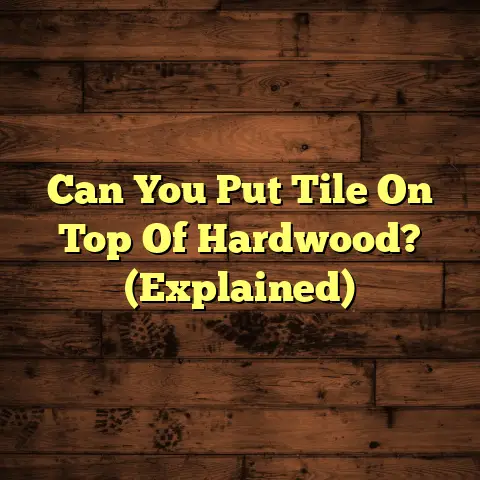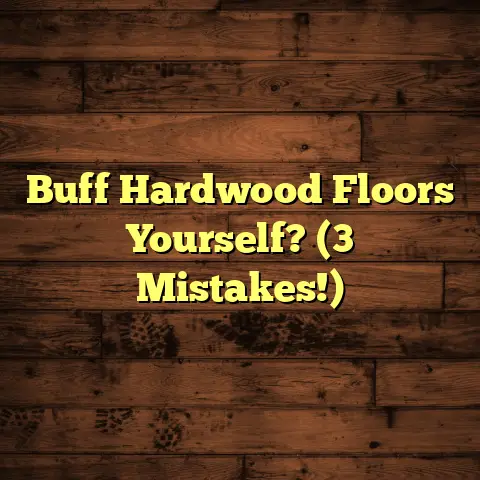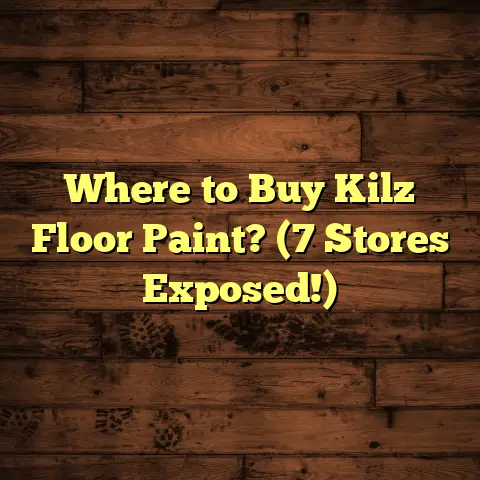Buffing After Waxing Floors? (6 Things to Know!)
Think about it: a gleaming hardwood floor can bring warmth and elegance, while a vibrant tile design can inject personality and flair.
Just like a masterpiece painting, your floors deserve the best care to keep them looking their best for years to come.
Now, you might be thinking, “Art?
It’s just a floor!” But trust me, the difference between a well-maintained floor and one that’s neglected is like the difference between a Van Gogh and a… well, a child’s scribble.
And that’s where buffing after waxing comes in.
It’s a crucial step that can transform your floors from dull and lifeless to vibrant and eye-catching.
So, grab a cup of coffee, and let’s dive into the world of floor care artistry!
Section 1: The Importance of Waxing Floors: More Than Just Shine
Okay, let’s talk waxing.
Why is it so important?
Well, beyond that beautiful shine you get, waxing acts like a shield for your floors.
Think of it as sunscreen for your wood, vinyl, tile or laminate.
It protects against the daily grind of dirt, spills, and scuffs that can dull and damage your investment.
I’ve seen it all, from muddy paw prints to spilled red wine, and a good wax coating can make all the difference in preventing permanent damage.
There’s a whole world of waxes out there, each designed for specific flooring types.
For example, you’ve got paste waxes for hardwood which gives a classic, durable finish.
Then there are liquid acrylic waxes, which are popular for vinyl and linoleum due to their ease of application and shine.
I always tell my clients to choose a wax specifically formulated for their floor type to get the best results.
Regular waxing does wonders.
It not only enhances the color and texture of your floors, making them look richer and more vibrant, but it also extends their lifespan.
I’ve seen properly waxed floors last decades longer than those left unprotected.
It’s an investment that truly pays off!
Section 2: Understanding the Buffing Process: Smoothing the Canvas
So, what exactly is buffing?
It’s the process of using a floor buffer (a machine with a rotating pad) to smooth out the surface of your waxed floor.
This enhances the shine and removes any minor imperfections, like streaks or cloudiness, left behind after waxing.
Think of it like polishing a car after applying wax.
You’re taking that protective layer and making it even smoother and more reflective.
Now, a lot of people confuse buffing with polishing, and while they both involve making your floors shinier, they’re not the same thing.
Polishing typically involves using abrasive compounds to remove scratches and imperfections from the floor’s surface itself.
Buffing, on the other hand, is a gentler process that focuses on enhancing the wax layer.
It’s a crucial step specifically after waxing to achieve that showroom-worthy finish.
Section 3: The Right Time to Buff After Waxing: Patience is Key
Timing is everything when it comes to buffing.
Buff too soon, and you’ll end up smearing the wax and creating a sticky mess.
Wait too long, and the wax will harden, making it difficult to achieve a smooth, even shine.
So, what’s the sweet spot?
As a general rule, I recommend waiting at least 24 hours after waxing before buffing.
This allows the wax to fully dry and cure.
However, several factors can affect this timing.
Humidity, for instance, can slow down the drying process, while warmer temperatures can speed it up.
The type of wax you use also plays a role.
Some waxes are formulated to dry faster than others.
Always check the manufacturer’s instructions for specific drying times.
How do you know when the wax is ready to be buffed?
Here’s a little trick I use: lightly touch the waxed surface in an inconspicuous area.
If the wax feels dry and firm, it’s good to go.
If it feels tacky or soft, give it more time.
Section 4: Tools and Techniques for Effective Buffing: Mastering the Machine
Alright, let’s talk tools and techniques.
You’ll need a floor buffer, which you can rent from most hardware stores.
There are two main types of buffers: rotary buffers and orbital buffers.
Rotary buffers are more powerful and aggressive, making them ideal for large areas and heavy-duty buffing.
Orbital buffers are gentler and easier to control, making them a good choice for smaller areas and beginners.
I generally recommend orbital buffers for homeowners.
You’ll also need buffing pads.
These come in various materials, such as cotton, wool, and synthetic fibers.
The type of pad you use will depend on your flooring type and the type of wax you used.
For example, a soft cotton pad is great for polishing hardwood floors, while a more abrasive wool pad might be needed for vinyl or tile.
Here’s a step-by-step guide to buffing your floors:
- Prepare the area: Remove all furniture and obstacles from the floor.
Sweep or vacuum thoroughly to remove any dirt or debris. - Attach the buffing pad to the buffer: Make sure the pad is securely attached and centered on the buffer head.
- Apply a small amount of wax to the pad: This will help lubricate the pad and prevent it from scratching the floor.
- Start buffing in a corner of the room: Use a slow, overlapping motion to cover the entire floor.
- Maintain a consistent pressure: Avoid pressing down too hard, as this can damage the floor.
- Overlap each pass by about 50%: This will ensure that the entire floor is buffed evenly.
- Continue buffing until the floor has a uniform shine: This may take several passes.
- Remove any excess wax with a clean, dry cloth: This will help prevent the floor from becoming sticky or slippery.
Safety first!
Always wear eye protection and hearing protection when operating a floor buffer.
And be sure to read the manufacturer’s instructions carefully before using the machine.
Section 5: Common Mistakes to Avoid When Buffing: Learning from My Oops Moments
Over the years, I’ve seen (and made!) my fair share of buffing blunders.
Here are some common mistakes to avoid:
- Over-buffing: Buffing for too long or with too much pressure can actually dull the floor’s finish.
- Using the wrong pads: Using an abrasive pad on a delicate floor can cause scratches and damage.
- Applying too much pressure: Pressing down too hard on the buffer can leave swirl marks and uneven patches.
- Buffing a dirty floor: Buffing dirt and debris into the wax can scratch the floor and create a cloudy finish.
- Not overlapping passes: Failing to overlap each pass can result in an uneven shine.
If you make a mistake, don’t panic!
Most buffing errors can be corrected with a little patience and the right techniques.
For example, if you notice swirl marks, try buffing the area again with a clean pad and a lighter touch.
If you scratch the floor, you may need to re-wax the affected area.
Section 6: Maintaining Your Floors Post-Buffing: Keeping the Shine Alive
Okay, you’ve waxed and buffed your floors to perfection.
Now, how do you keep them looking that way?
Regular maintenance is key. Here are some tips:
- Sweep or vacuum regularly: This will remove dirt and debris before they can scratch the floor.
- Mop with a damp cloth: Use a mild detergent specifically designed for waxed floors.
- Avoid harsh chemicals and abrasive cleaners: These can strip the wax and damage the floor.
- Use mats and rugs in high-traffic areas: This will protect the floor from wear and tear.
- Re-wax as needed: Depending on the amount of traffic, you may need to re-wax your floors every 6-12 months.
Here is a table showing “Waxing Frequency”:
Note: These are general recommendations.
Always refer to the manufacturer’s instructions for your specific flooring and wax products.
Conclusion: The Art of Floor Care: A Labor of Love
There you have it!
Buffing after waxing is an art form that combines technique, timing, and the right tools.
It’s not just a chore; it’s an essential part of preserving your flooring’s artistic value.
With the right knowledge and practices, you can keep your floors looking stunning for years to come.
So, embrace the art of floor care, and let your floors shine!
Remember, a well-maintained floor not only looks beautiful but also adds value to your home.
It’s an investment that you’ll enjoy every day.





